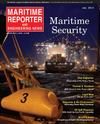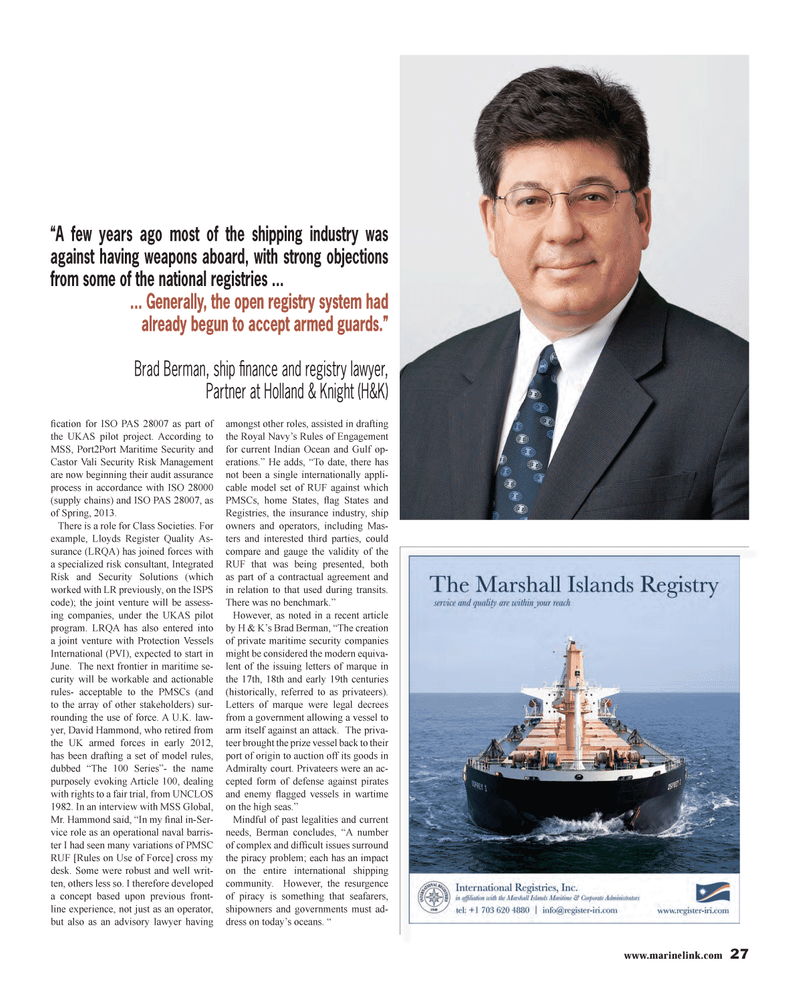
Page 27: of Maritime Reporter Magazine (July 2013)
Maritime Security Edition
Read this page in Pdf, Flash or Html5 edition of July 2013 Maritime Reporter Magazine
www.marinelink.com 27Þ cation for ISO PAS 28007 as part of the UKAS pilot project. According to MSS, Port2Port Maritime Security and Castor Vali Security Risk Management are now beginning their audit assurance process in accordance with ISO 28000 (supply chains) and ISO PAS 28007, as of Spring, 2013. There is a role for Class Societies. For example, Lloyds Register Quality As- surance (LRQA) has joined forces with a specialized risk consultant, Integrated Risk and Security Solutions (which worked with LR previously, on the ISPS code); the joint venture will be assess-ing companies, under the UKAS pilot program. LRQA has also entered into a joint venture with Protection Vessels International (PVI), expected to start in June. The next frontier in maritime se- curity will be workable and actionable rules- acceptable to the PMSCs (and to the array of other stakeholders) sur- rounding the use of force. A U.K. law- yer, David Hammond, who retired from the UK armed forces in early 2012, has been drafting a set of model rules, dubbed ÒThe 100 SeriesÓ- the name purposely evoking Article 100, dealing with rights to a fair trial, from UNCLOS 1982. In an interview with MSS Global, Mr. Hammond said, ÒIn my Þ nal in-Ser- vice role as an operational naval barris-ter I had seen many variations of PMSC RUF [Rules on Use of Force] cross my desk. Some were robust and well writ-ten, others less so. I therefore developed a concept based upon previous front-line experience, not just as an operator, but also as an advisory lawyer having amongst other roles, assisted in drafting the Royal NavyÕs Rules of Engagement for current Indian Ocean and Gulf op-erations.Ó He adds, ÒTo date, there has not been a single internationally appli-cable model set of RUF against which PMSCs, home States, ß ag States and Registries, the insurance industry, ship owners and operators, including Mas-ters and interested third parties, could compare and gauge the validity of the RUF that was being presented, both as part of a contractual agreement and in relation to that used during transits. There was no benchmark.ÓHowever, as noted in a recent article by H & KÕs Brad Berman, ÒThe creation of private maritime security companies might be considered the modern equiva-lent of the issuing letters of marque in the 17th, 18th and early 19th centuries (historically, referred to as privateers). Letters of marque were legal decrees from a government allowing a vessel to arm itself against an attack. The priva- teer brought the prize vessel back to their port of origin to auction off its goods in Admiralty court. Privateers were an ac-cepted form of defense against pirates and enemy ß agged vessels in wartime on the high seas.Ó Mindful of past legalities and current needs, Berman concludes, ÒA number of complex and difÞ cult issues surround the piracy problem; each has an impact on the entire international shipping community. However, the resurgence of piracy is something that seafarers, shipowners and governments must ad-dress on todayÕs oceans. Ò ?A few years ago most of the shipping industry was against having weapons aboard, with strong objections from some of the national registries ... ... Generally, the open registry system had already begun to accept armed guards.? Brad Berman, ship Þ nance and registry lawyer, Partner at Holland & Knight (H&K)MR #7 (26-33).indd 27MR #7 (26-33).indd 277/2/2013 3:49:34 PM7/2/2013 3:49:34 PM

 26
26

 28
28
